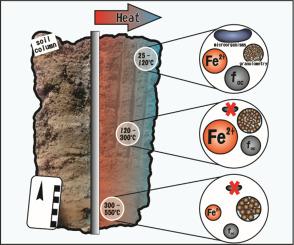Journal of Contaminant Hydrology ( IF 3.6 ) Pub Date : 2021-03-31 , DOI: 10.1016/j.jconhyd.2021.103808 Ellen Caroline Puglia Leite 1 , Fábio Minzon Rodrigues 1 , Tatiana Satiko Terada Horimouti 1 , Mirian Chieko Shinzato 2 , Cristina Rossi Nakayama 2 , Juliana Gardenalli de Freitas 2

|
Some remediation techniques, such as thermal remediation, can significantly change the soil properties. These changes can be beneficial or detrimental to the sequential application of Nature-based Solutions. This work evaluated the effects of thermal remediation on the properties of two tropical soils (Technosol and Oxisol), and discuss how these changes might impact both biotic and abiotic degradation processes. Bench tests using disturbed samples were performed under oxic and anoxic conditions, whereas 3D physical models were used to simulate the heat distribution along undisturbed samples. The changes in soils texture, density, hydraulic conductivity, iron concentration, mineralogy and microbiota were evaluated. The properties of Oxisol were more affected than those of Technosol due to the higher levels in Fe(III), organic carbon and finer texture. When heated in the range of 120 to 300 °C under oxic and anoxic conditions, the Fe(II) content and the magnetism intensity increased in Oxisol, probably due to the formation of magnetite. Under oxic conditions, the burning of Oxisol organic matter promoted an anoxic atmosphere, favoring the formation of Fe(II). However, the continuous increase of the temperature (>300 °C) lead to the decrease of Fe(II) due to the transformation of magnetite to maghemite, and then to hematite. The heating process also promoted some minerals decomposition and cementation of the clay fraction, increasing the soil texture. Bacterial populations were impacted, but showed ability to recover at 60 °C. However, above 100 °C no culturable cells were recovered and at temperatures above 270 °C soil sterilization occurred. The changes observed, especially in Oxisol samples, indicated that mild heating (between 120 and 240 °C), in turn, can increase the potential for abiotic degradation of some contaminants, such as chlorinated solvents. Therefore, heating conditions up to 240 °C during thermal remediation can be defined as to promote beneficial changes in soil properties, increasing its potential for natural attenuation by abiotic processes even when the microbiota is affected, and improving its sustainability.
中文翻译:

热带土壤性质的热致变化及其对基于自然的连续解决方案的潜在影响
一些修复技术,如热修复,可以显着改变土壤特性。这些变化可能对基于自然的解决方案的顺序应用有利或不利。这项工作评估了热修复对两种热带土壤(Technosol 和 Oxisol)特性的影响,并讨论了这些变化如何影响生物和非生物降解过程。在有氧和缺氧条件下使用受干扰样品进行台架测试,而使用 3D 物理模型来模拟沿未受干扰样品的热量分布。评估了土壤质地、密度、水力传导率、铁浓度、矿物学和微生物群的变化。Oxisol的特性比Technosol的特性受到的影响更大由于 Fe(III)、有机碳和更细的质地含量较高。当在有氧和缺氧条件下在 120 至 300 °C 范围内加热时,Oxisol 中的 Fe(II) 含量和磁性强度增加,这可能是由于磁铁矿的形成。在有氧条件下,Oxisol 有机物的燃烧促进了缺氧气氛,有利于 Fe(II) 的形成。然而,由于磁铁矿转变为磁赤铁矿,然后转变为赤铁矿,温度的持续升高(> 300 °C)导致 Fe(II) 的减少。加热过程也促进了一些矿物质的分解和黏土部分的胶结,增加土壤质地。细菌种群受到影响,但在 60 °C 下显示出恢复能力。然而,在 100 °C 以上没有回收到可培养的细胞,并且在 270 °C 以上的温度下发生土壤消毒。观察到的变化,特别是在 Oxisol 样品中,表明温和加热(120 至 240 °C)反过来会增加某些污染物(如氯化溶剂)非生物降解的可能性。因此,热修复过程中高达 240°C 的加热条件可以定义为促进土壤性质的有益变化,即使在微生物群受到影响的情况下,也能增加其通过非生物过程自然衰减的潜力,并提高其可持续性。



























 京公网安备 11010802027423号
京公网安备 11010802027423号